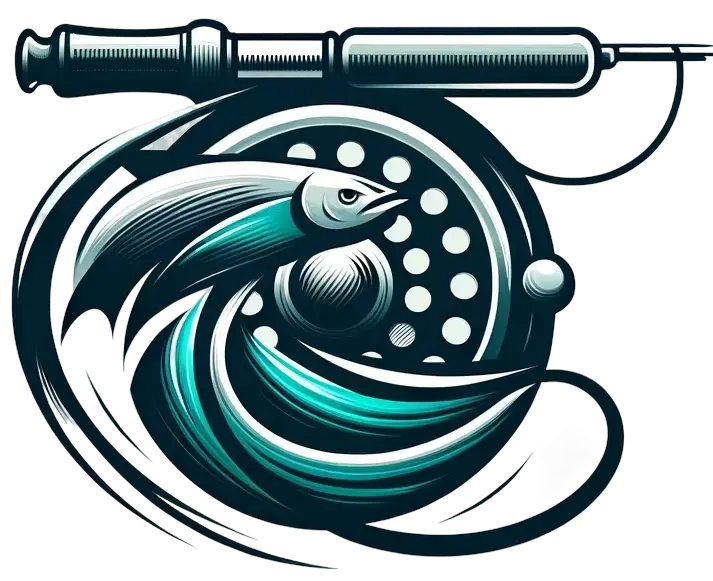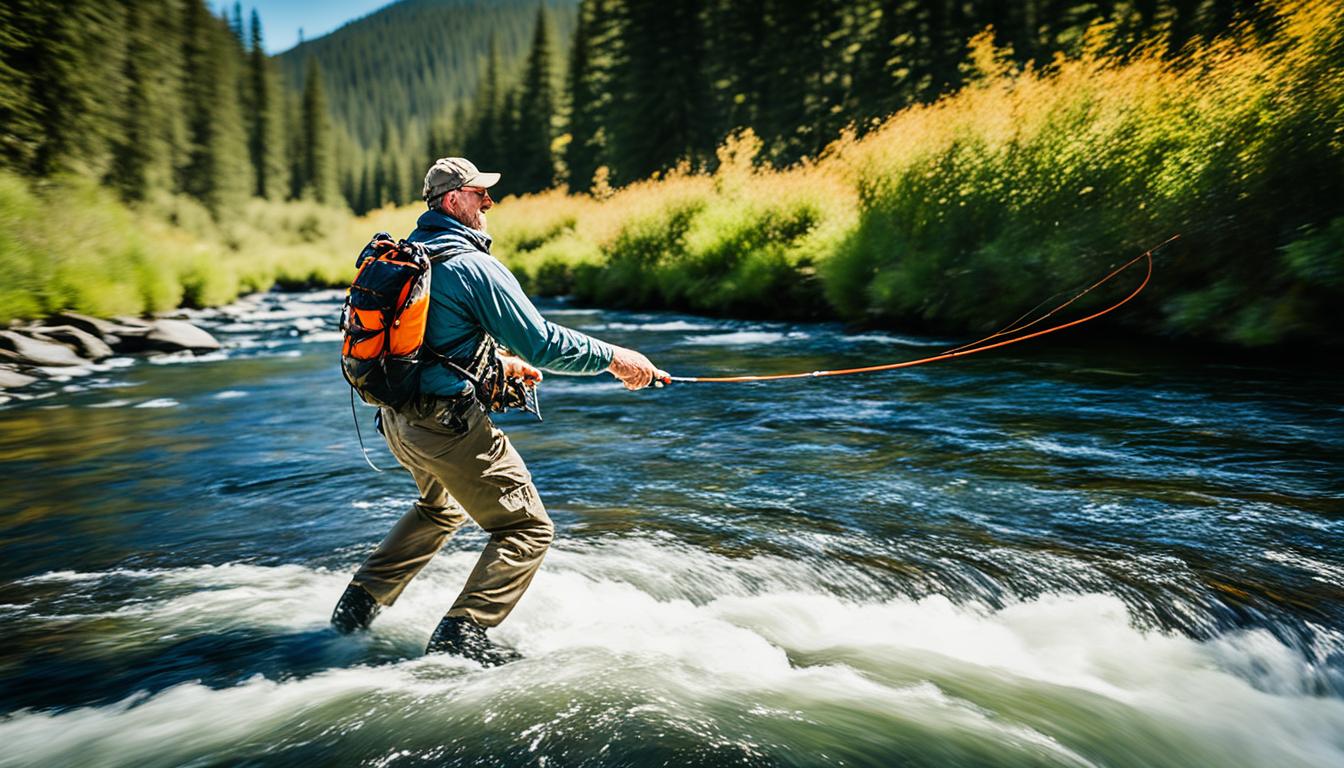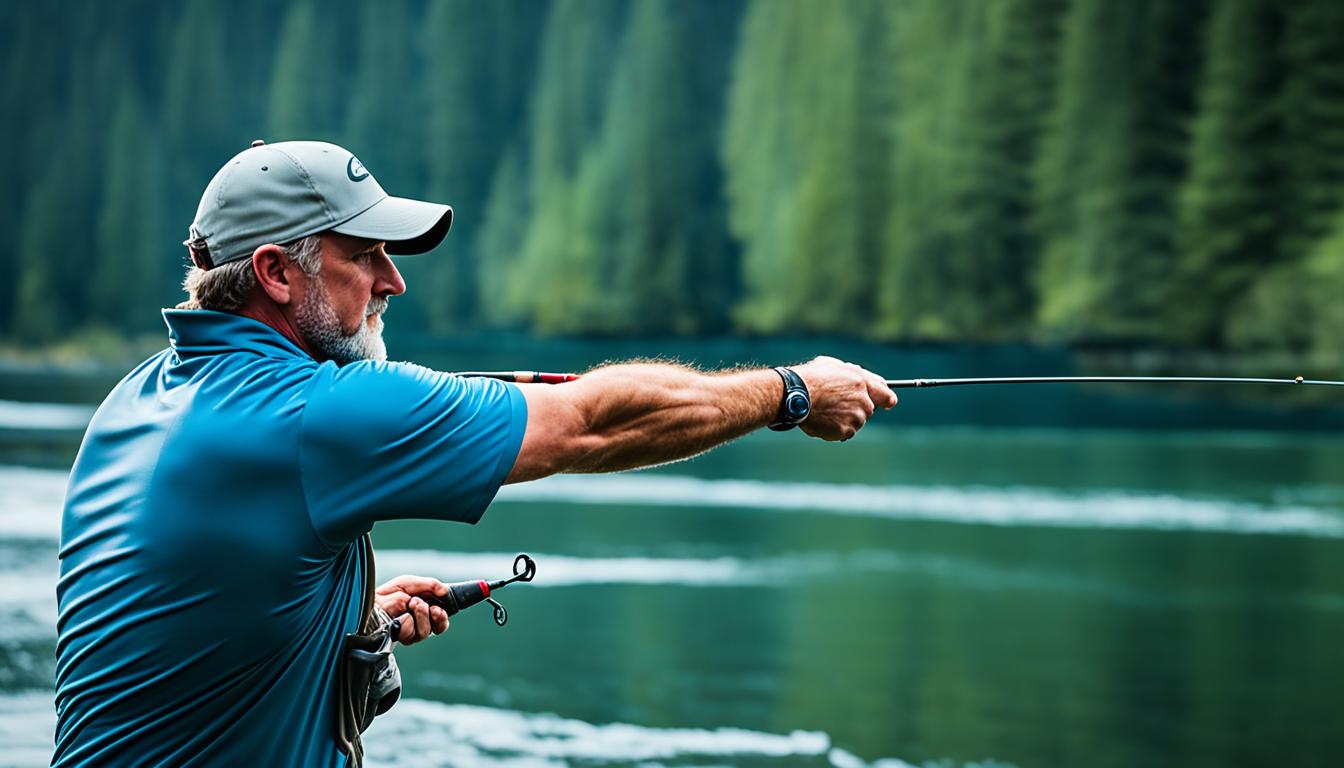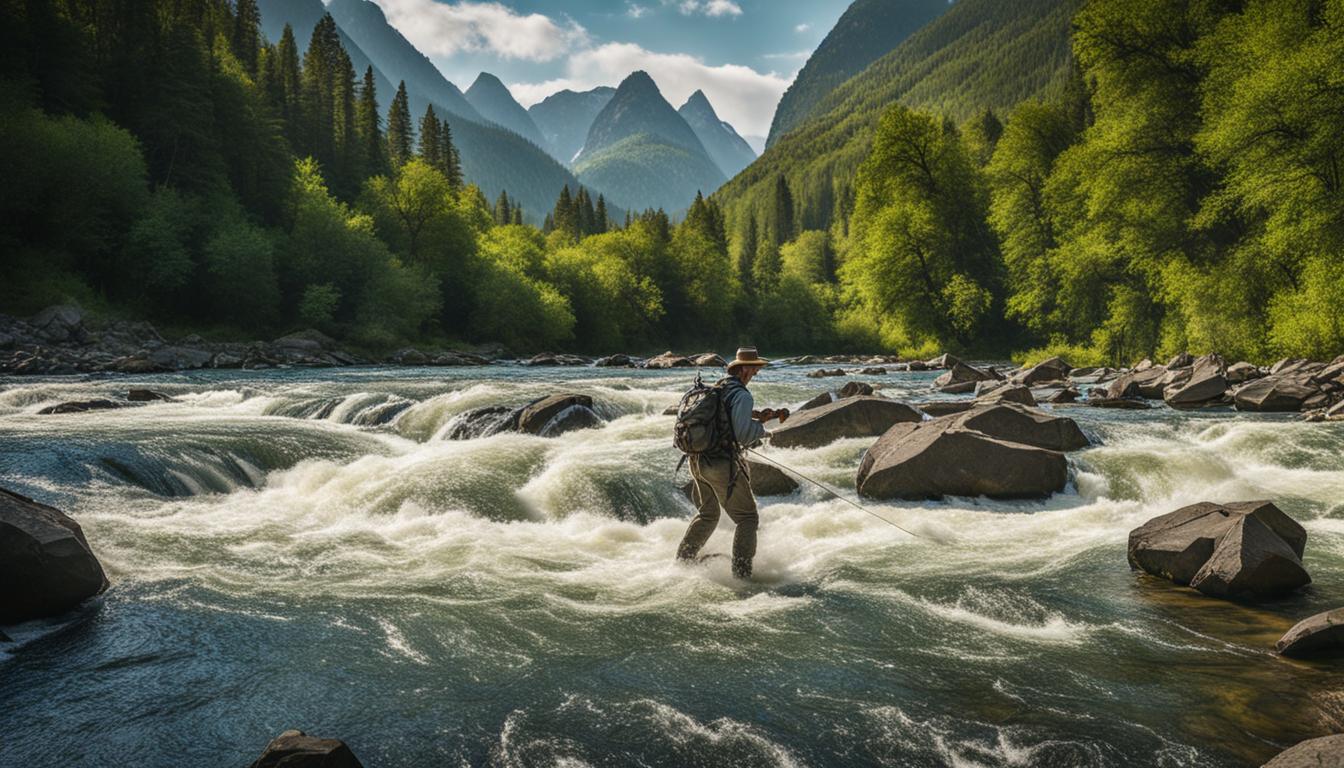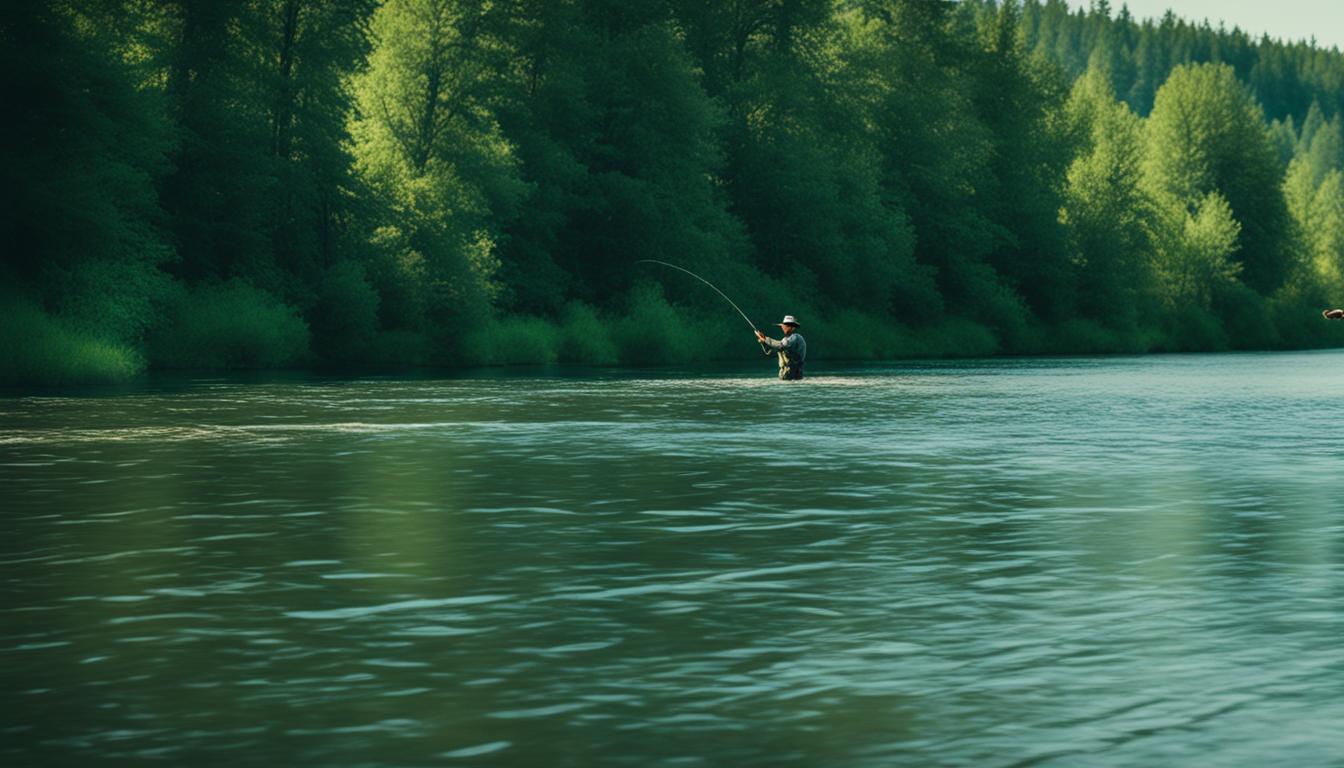Nymphing is an essential technique in fly fishing that involves presenting nymphs, which are aquatic insect imitations, to the fish below the surface. It is a highly effective method for catching trout and other species. In this article, we will explore the basics of nymphing and go beyond the fundamentals to cover advanced nymphing techniques. Whether you are a beginner or an experienced angler, this comprehensive guide will help you elevate your nymphing skills and catch more fish.
Key Takeaways:
- Learn the fundamentals of nymphing to effectively present nymphs to fish below the surface.
- Discover advanced nymphing techniques to take your nymphing skills to the next level.
- Understand the importance of speeding up subsurface presentations in nymphing.
- Explore different nymphing techniques like the basic swing and the parallel induced lift.
- Get tips for fishing nymphs in stillwaters, such as lakes and ponds.
The Importance of Speeding up Subsurface Presentations in Nymphing
One important aspect of nymphing is the ability to speed up subsurface presentations. While the traditional dead drift, where the nymph drifts naturally with the current, is effective in most scenarios, there are times when inducing drag and moving the nymph faster than the current can be more productive.
During peak insect hatch periods, trout are conditioned to insects emerging towards the surface. By inducing drag and creating vertical movement towards the surface, anglers can imitate the natural behavior of emerging insects and attract more strikes.
Speeding up subsurface presentations adds another dimension to nymphing tactics, increasing the chances of enticing trout to strike. This technique can be particularly effective when fishing in fast-moving currents or when targeting aggressive fish.
“By inducing drag and creating vertical movement towards the surface, anglers can imitate the natural behavior of emerging insects and attract more strikes.”
Nymphing Tactics: Maximizing Success with Speed
When speeding up subsurface presentations, it’s crucial to maintain control over the nymph and induce drag effectively. Here are a few tactics to consider:
- Short-line Nymphing: Using a shorter line allows for more precise control and manipulation of the nymph. By reducing the amount of slack line, anglers can quickly move the nymph upstream or across the current, imitating the movement of an emerging insect.
- Adding Weight: By adding split shot or weighted flies to the nymphing rig, you can increase the speed at which the nymph sinks and moves through the water. This provides a more realistic presentation and allows you to reach deeper water more effectively.
- Varying the Retrieve: Experiment with different retrieve techniques, such as short, quick strips or a twitching action, to imitate the movements of an insect. This erratic movement can trigger aggressive strikes from predatory trout.
Remember, nymphing is all about imitating the natural behavior of aquatic insects. By speeding up subsurface presentations and inducing drag, you can mimic the movements of emerging insects and increase your chances of success.
Quotes from Expert Anglers:
“When fish are focused on emergers, speeding up your nymph presentation can be a game-changer. It imitates the action of bugs rising towards the surface and triggers aggressive strikes.” – Martin Smith, Fly Fishing Magazine
Nymphing Techniques: The Basic Swing and the Parallel Induced Lift
When it comes to nymphing, there are a variety of techniques you can use to effectively present your nymphs to fish. Two common and effective techniques are the basic swing and the parallel induced lift. Let’s take a closer look at each technique.
The Basic Swing
The basic swing is a versatile nymphing technique that can be employed in a variety of fishing scenarios. The basic swing involves lowering the rod tip at the end of a nymphing drift and slowly pulling the flies towards you. This creates a natural swinging motion that can entice fish to strike.
This technique is particularly useful when fishing in areas with moderate to fast currents. By allowing the nymphs to swing across the current, you can cover a wide range of water and increase your chances of encountering fish. The basic swing is also effective when fishing in the swing stage, which is when the nymphs are moving across the current before starting to rise towards the surface.
Remember to maintain tension on the line while performing the basic swing to ensure you can detect subtle strikes. It’s important to stay vigilant and be ready to set the hook when you feel any indications of a strike.
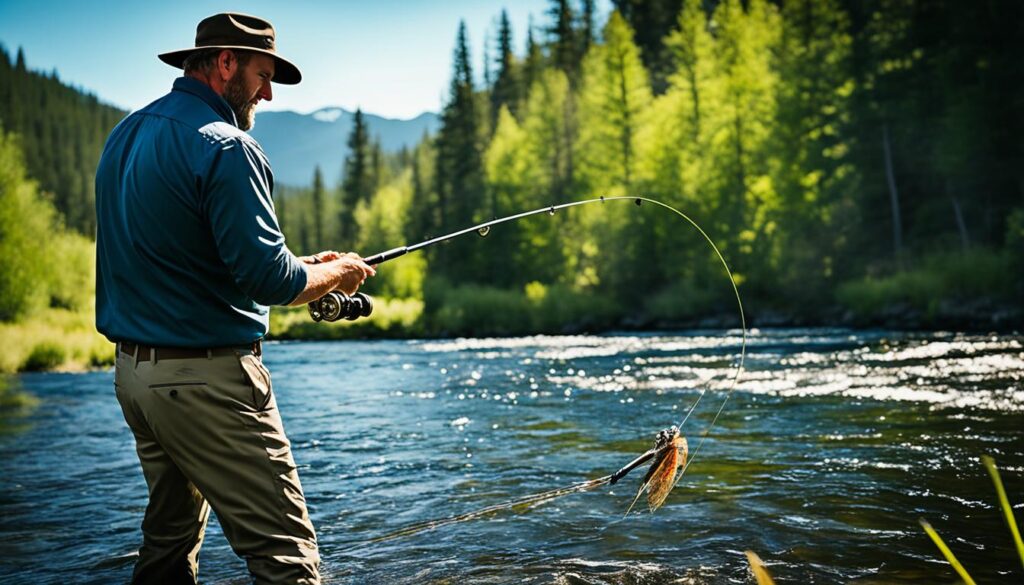
The Parallel Induced Lift
The parallel induced lift is another effective nymphing technique that can be used to target specific holding areas or seams in a river or stream. This technique involves keeping the rod tip held higher off the water and stopping it over a specific seam or current where you want to swing your nymph patterns.
As you raise the rod tip, the nymphs will be lifted just below the surface, imitating the natural behavior of emerging insects. This can trigger strikes from fish that are keying in on insects close to the surface.
The parallel induced lift is particularly effective when fishing in slower-moving water or during periods of insect activity. By targeting specific areas with this technique, you can increase your chances of presenting your nymphs in front of feeding fish and provoke strikes.
As with any nymphing technique, it’s important to pay close attention to the movements of your line and the behavior of the fish. Adjust your presentation and technique as needed to maximize your chances of success.
Nymphing Techniques Comparison
| Nymphing Technique | Suitable Fishing Scenarios | Advantages |
|---|---|---|
| The Basic Swing | Areas with moderate to fast currents, swing stage | – Covers a wide range of water – Mimics the natural swinging motion of nymphs – Can entice strikes from fish |
| The Parallel Induced Lift | Specific holding areas, seams, slower-moving water | – Targets specific areas where fish are feeding – Mimics the behavior of emerging insects – Can trigger strikes from fish close to the surface |
Both the basic swing and the parallel induced lift are valuable nymphing techniques that can help you catch more fish. As with any technique, practice and experimentation are key to mastering these techniques and understanding when to use each one. By incorporating these techniques into your nymphing arsenal, you’ll be well-equipped to tackle a variety of fishing situations and increase your chances of success.
Tips for Fishing Nymphs in Stillwaters
Nymph fishing in stillwaters, such as lakes or ponds, is a popular technique among fly anglers. To effectively fish nymphs in stillwaters, it is important to select the right nymph patterns that imitate the insects present in the water. Imtative nymph patterns closely resemble the actual nymphs, while suggestive nymph patterns have more lure-like characteristics.
When fishing nymphs in stillwaters, it’s crucial to vary the retrieve techniques to mimic the natural movement of nymphs and entice strikes from stillwater trout. Slow retrieves with occasional pauses or quick bursts can imitate the erratic behavior of nymphs, making them irresistible to hungry trout.
Here are some key tips for fishing nymphs in stillwaters:
- Select imitative nymph patterns that closely resemble the insects in the water. This will increase your chances of fooling the trout.
- Experiment with suggestive nymph patterns that have more enticing movement and appeal to aggressive trout.
- Vary your retrieve techniques to imitate the natural movement of nymphs. Alternate between slow retrieves, pauses, and quick bursts to trigger strikes.
- Pay attention to the depth at which you are fishing. Use an appropriate weight system to ensure your nymphs stay within the target feeding zone of stillwater trout.
By applying these tips and techniques, you can enhance your stillwater nymph fishing skills and increase your chances of success in catching trout. Remember to observe the behavior of the fish and adjust your strategy accordingly. Happy fishing!
The Life Cycle of Nymphs and Their Importance in Fly Fishing
Nymphs, the immature stages of insects, are a vital component of the aquatic ecosystem. They play a crucial role in the food chain as a significant source of food for fish, including trout. Understanding the life cycle of nymphs and their importance in fly fishing is essential for fly anglers seeking success on the water.
Various insect orders, such as Odonata, Ephemeroptera, and Plecoptera, contain nymphs. These aquatic insects inhabit freshwater environments, including rivers, streams, and lakes, where they undergo incomplete metamorphosis. Unlike insects that undergo complete metamorphosis, nymphs do not have a pupal stage. Instead, they gradually develop into adult insects without undergoing a distinct transformation.
During their nymphal stage, these aquatic insects serve as a primary food source for fish. Nymphs provide a year-round supply of sustenance for fish, especially when there is limited insect activity on the water’s surface. This makes nymph imitations highly effective for fly anglers looking to entice strikes from fish.
As fly anglers, we seek to imitate the appearance and behavior of nymphs with artificial fly patterns. By using nymph imitations, such as Pheasant Tail Nymphs or Hare’s Ear Nymphs, we can fool fish into believing that our flies are the real nymphs they feed on. The use of accurate imitations is crucial for enticing fish to bite and enhancing our chances of success.
By studying the life cycle of nymphs and gaining knowledge of the most prevalent species in our fishing area, we can select fly patterns that closely resemble the natural nymphs found in the water. This attention to detail increases the likelihood of fooling fish and triggering more strikes.
Whether fishing a nymph below an indicator, tight-lining, or using other nymphing techniques, a thorough understanding of nymph life cycles allows us to present our flies in a more convincing manner. This enhances our ability to fool fish and increases our chances of hooking into those elusive trout.
To summarize, nymphs are essential in the insect life cycle and serve as a critical food source for fish, making them a prime target for fly anglers. By imitating nymphs with artificial fly patterns, we can effectively attract and fool fish into biting. Understanding the life cycle of nymphs and selecting the right nymph imitations greatly enhances our success as fly anglers.
Next, let’s explore the gear needed for successful nymphing in section 6.
Nymphing Gear: Rods, Lines, and Leaders
When it comes to nymphing gear, selecting the right equipment is crucial for a successful nymph fishing experience. Let’s dive into the essential gear you’ll need for nymphing: nymphing rods, fly lines, and leaders.
Nymphing Rods
Choosing the right nymphing rod is the foundation of your setup. Nymphing rods should provide excellent line control and have a suitable length of around 9 to 10 feet. These longer rods allow for precise presentations and better line management, ensuring that you can effectively control your nymph drifts. Look for rods specifically designed for nymphing, as they often have features like sensitive tips and a balanced action that enhance your ability to detect subtle strikes.
Fly Lines
The choice of fly lines for nymphing depends on the desired fishing depth. Floating lines are suitable for shallow water nymphing, where you want to keep your nymphs near the surface. On the other hand, if you want to target deeper water or faster currents, intermediate sinking lines are ideal. These sinking lines will help you get your nymphs down to the desired depth quickly and keep them in the strike zone for longer periods.
Leaders
Leaders play a vital role in the nymphing setup, as they are responsible for delivering your nymphs to the desired location with a natural presentation. When selecting leaders for nymphing, opt for longer leaders than your fly rod, typically around 9 to 12 feet. The longer length allows for a smoother turnover and ensures that your nymphs aren’t spooking the fish by landing directly on top of them. Additionally, consider using tapered leaders to further optimize your nymphing setup.
It’s important to note that nymphing gear can vary depending on the specific fishing situation, such as the depth of the water, the size of the nymphs being used, and the desired presentation. Adjusting your setup according to these factors will help you achieve optimal results on the water.
Now that we have covered the basics of nymphing gear, let’s take a look at a summary of the key points in the table below:
| Nymphing Gear | Features | Considerations |
|---|---|---|
| Nymphing Rods | – Length: 9 to 10 feet – Excellent line control – Sensitive tips |
– Designed specifically for nymphing |
| Fly Lines | – Floating lines for shallow water nymphing – Intermediate sinking lines for deeper water |
– Consider fishing depth and current speed |
| Leaders | – Longer than the fly rod (9 to 12 feet) – Tapered leaders for smooth turnover |
– Allow for a natural presentation – Avoid landing nymphs directly on fish |
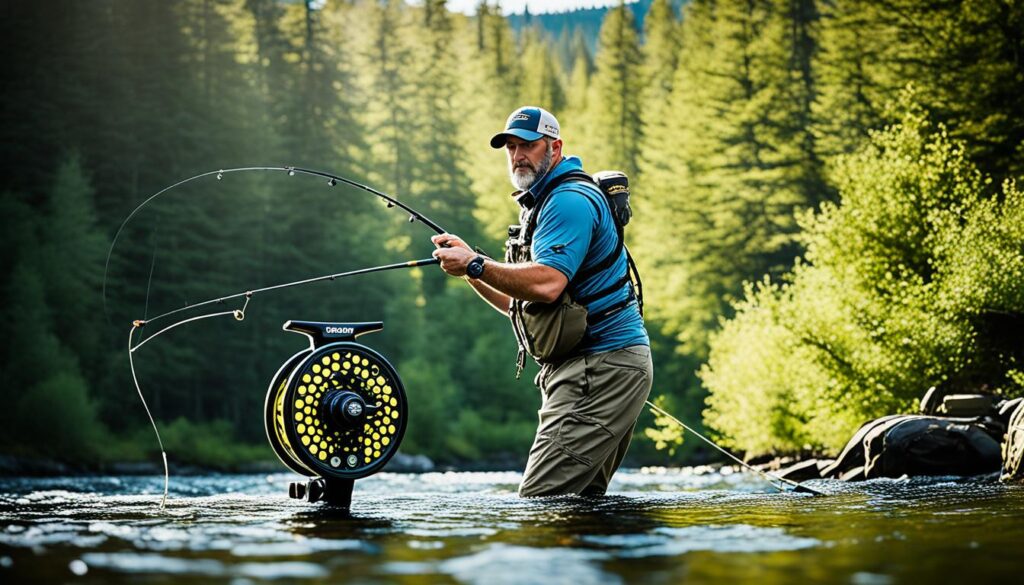
Conclusion
Nymphing is a versatile and effective technique in fly fishing that offers anglers the opportunity to catch trout and other species. By mastering the basics of nymphing and exploring advanced techniques, we can elevate our skills and increase our chances of success on the water.
Understanding the life cycle of nymphs and their importance as a food source for fish help us choose the right nymph patterns for our fishing conditions. Whether imitating the appearance of nymphs with lifelike imitations or using suggestive patterns to entice strikes, our understanding of the insect life cycle gives us a competitive edge.
Selecting the appropriate nymphing gear, such as rods, lines, and leaders, is crucial for proper presentation and success in nymph fishing. The right equipment, combined with proper technique, allows us to present nymphs effectively at different depths and currents to attract fish in stillwaters and rivers alike.
Incorporating these tips and techniques into our nymphing arsenal will help us become more skilled and successful fly anglers. So grab your nymphing gear, study the insect life cycle, and get ready to explore the exciting world of nymphing techniques for stillwater trout fishing. Happy fishing!
FAQ
What is nymphing?
Nymphing is a fly fishing technique that involves presenting nymphs, which are aquatic insect imitations, to the fish below the surface.
Why is nymphing important in fly fishing?
Nymphing is important in fly fishing because it is a highly effective method for catching trout and other species.
What is the importance of speeding up subsurface presentations in nymphing?
Speeding up subsurface presentations in nymphing can imitate the natural behavior of emerging insects during peak insect hatch periods and attract more strikes.
What are the common nymphing techniques?
Two common nymphing techniques are the basic swing and the parallel induced lift.
How can I effectively fish nymphs in stillwaters?
To effectively fish nymphs in stillwaters, it is important to select the right nymph patterns that imitate the insects present in the water and vary your retrieve techniques.
What are nymphs in fly fishing?
Nymphs are the immature stages of insects that undergo incomplete metamorphosis and serve as a significant food source for fish, including trout.
What gear do I need for nymphing?
Nymphing gear includes nymphing rods, fly lines, and leaders that are suitable for controlling the line and presenting the nymphs effectively.
How can I improve my nymphing skills?
You can improve your nymphing skills by mastering the basics of nymphing, exploring advanced techniques, understanding the life cycle of nymphs, and selecting the appropriate nymphing gear.
